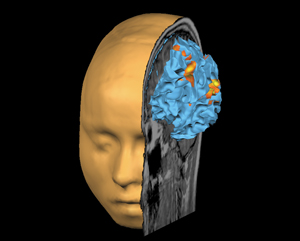
New imaging techniques allow investigators to observe changes in brain regions. (Chris Cannistraci/VUIIS)
VUMC Reporter Series: Neuroimaging expands research frontiers

Ronald Cowan, M.D., Ph.D.
Psychiatric neuroimaging holds enormous promise for helping investigators unravel the mysteries of the human mind.
Unlike any other point in human history, psychiatric researchers today have the ability to explore the neuronal basis of thought and emotion in living humans. Powerful neuroimaging techniques, such as functional magnetic resonance imaging, or fMRI, allow investigators to observe the activity, structure and chemical makeup of specific brain regions involved in ideas, emotions and illness.
“The opportunity to define psychiatric disorders at the level of the brain is now becoming a reality,” said Ronald Cowan, M.D., Ph.D., director of the Psychiatric Neuroimaging Program in the Vanderbilt Department of Psychiatry.
With the establishment of the Vanderbilt University Institute of Imaging Science (VUIIS) in 2002 under the leadership of John Gore, Ph.D., Vanderbilt acquired the ability to pursue state-of-the-art studies of the human brain.
While psychiatric neuroimaging projects were already in progress at Vanderbilt, Stephan Heckers, M.D., who became chair of the Department of Psychiatry in 2005, identified neuroimaging research as a priority.
Established in 2006, the Psychiatric Neuroimaging Program aims to understand the mechanisms of a broad spectrum of psychiatric illnesses and behaviors, from schizophrenia, depression and autism to substance abuse, obesity and temperament.
The program seeks to foster multimodal, multidisciplinary research addressing the etiology, pathophysiology and treatment of mental illness. It supports research and teaching initiatives in collaboration with scientists throughout Vanderbilt and the world.
More than 30 researchers currently are affiliated with the program. Cowan and Heckers are continuing to recruit new faculty who can bring expertise and perspective relevant to specific mental illnesses.
“The ability to share ideas is tremendously important, especially in the challenging field of psychiatric neuroimaging,” said Cowan, assistant professor of Psychiatry and of Radiology and Radiological Sciences.
Located on the third floor of the Vanderbilt Psychiatric Hospital, the program offers access to brain imaging analysis computer systems for data analysis, eye tracking and head movement systems and physiological monitoring systems. Program investigators collaborate closely with VUIIS faculty, who bring their enormous technical neuroimaging expertise to bear upon the mechanisms of psychiatric illness.
Other collaborating centers at Vanderbilt include the newly established Conte Center for Neuroscience Research, directed by Randy Blakely, Ph.D.; the Vanderbilt Kennedy Center for Research on Human Development, directed by Pat Levitt, Ph.D.; the Clinical Research Center, directed by David Robertson, M.D.; the Vanderbilt Addiction Center, directed by Peter Martin, M.D.; and the Center for Integrative and Cognitive Neuroscience, directed by Jeff Schall, Ph.D.
While the diagnosis and treatment of psychiatric illnesses remain firmly rooted in traditions that require careful consideration of brain biology, psychological and social factors, understanding genetic and biological contributions to mental illness has become increasingly important.
“Neuroimaging has led us to realize that the major psychiatric illnesses are associated with structural brain changes,” Cowan said. “The implication of this simple message for the diagnosis and treatment of mental illness is profound.”
For more information about the Psychiatric Neuroimaging Program, click on www.vandypsychimaging.com. The imaging center Web site is www.vuiis.vanderbilt.edu.













